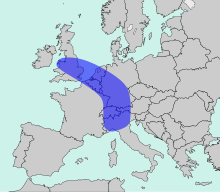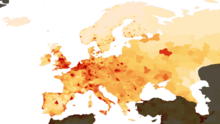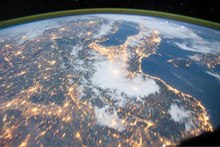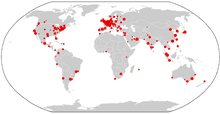Blue banana
The blue banana is a densely populated area with around 111 million inhabitants, a ribbon-shaped European metropolitan area between the Irish Sea and the Mediterranean , the urbanization of which forms a chain of metropolitan areas , which is also known as a megalopolis or mega-region. Due to the concentration of population , economy , knowledge and culture , capital , media , transport , settlement and infrastructure as well as due to its global interdependence, this area has a high degree of centrality and dynamism . Almost all central institutions of the European Union as well as 20 Global and World Cities are located in this area, including London and other centers of England , the centers of Benelux with the Brussels-Capital region and Randstad , the metropolises of the Rhine-Ruhr region , the Rhine Main area and the Upper Rhine Plain , Switzerland ( Basel and Zurich ) and northern Italy ( Milan ).
The term blue banana is based on an economic geographic model by a group around the French Roger Brunet from 1989, which characterizes an area of geographically relevant transformations, offers an explanation for the different population densities in Europe and divides the continent into so-called active and passive areas . The color blue was given to the model a few days after its first publication at a press conference and popularized by a subsequent newspaper article. The concepts of the golden banana and the blue star represent further developments or modifications of the model .
The one with the term blue banana marked compression chamber is not a result of a plan , but has in the course of long-term historical and market-based processes through colonization developed. Today this agglomeration is in close global competition and cooperation with other agglomeration areas in the world, such as the megalopolises BosWash , Chipitts or SanSan in the USA or the large metropolitan areas on the coasts and large rivers of Asia, such as the Japanese Taiheiyō Belt .
Geographical limitation

The blue banana has its northern end at the old industrial centers around Liverpool , Manchester and Birmingham ; then runs south through Great Britain via Greater London . On the European mainland it finally curves, including Flanders , the northern area of Belgium , the southern part of the Netherlands , the Randstad , the city region of Aachen , the Ruhr area , the agglomeration around Düsseldorf and the region of Cologne / Bonn . From the Rhine-Ruhr metropolitan region , it continues along the Rhine, enclosing Frankfurt am Main and the Rhine-Main area . Over the Rhine-Neckar leads to the metropolitan region of Stuttgart . At the apex of her arch she touches the metropolitan regions of Nuremberg and Munich . To the south it continues via the trinational metropolitan region of Upper Rhine to the metropolitan areas of Switzerland and finally ends in northern Italy at the northern Italian cities of Turin , Milan , Genoa , Bolzano , Verona and Bologna .
The Rhine forms the central development axis of the blue banana due to its historical function as an important transport and trade route in Europe.
The model of the Blue Banana , by the model of the Golden Banana are supplemented by the likewise dense metropolitan area along the Mediterranean coast (including the cities of Nice , Marseille , Montpellier and Barcelona ) to Valencia in Spain is taken into consideration.
The blue banana has a north-south extension of around 1300 km (west-east extension: around 900 km) and goes through nine countries, all of which - with the exception of Switzerland, the Principality of Liechtenstein and Great Britain - belong to the EU and represent the core of the same.
Origin of the concept and the term
The Frenchman Roger Brunet , who wanted to subdivide Europe into active and passive spaces, developed the term “blue banana” in 1989 with his group RECLUS. He was referring to a large European industrial and service area that stretches from northern England along the Rhine to Northern Italy . Brunet, however, did not see his thesis as a really new discovery, since it could already be seen beforehand with “a little understanding and spatial empathy”.
He saw the blue banana as a development of historical events, such as B. major trade routes , or as a result of the accumulation of industrial capital. France, however, lost contact with this metropolitan area mainly through the persecution of minorities , he called the Protestants ( Huguenot Wars ), and through centralization on Paris . Brunet therefore deliberately left out the French area, which is concentrated or restricted in particular to the greater Paris area, in order to show the French government the need for economic integration in this pan-European area. The Alsace , however, can - although situated in France - are still considered as part of the blue banana; historically it is part of the German-speaking area .
The banana was designated as blue because it is the European core area and the flag of Europe is predominantly blue (with yellow stars), so the flag color was adopted. Other sources, on the other hand, name work clothing - the term blue-collar worker , which mainly stands for factory workers , still exists in English - the mostly industrial workforce as the reason for the addition.
meaning
The blue banana is of particular importance not only because of the population density , which is expressed in an almost continuous city band over long stretches. The infrastructure - both traffic and information technology - is above average. The population density and the density of the centers create markets , result in logistical advantages and promote urbanity , diversification , interaction and innovation . Market participants can better engage in mutual exchange through proximity, which lowers their transport costs and travel times and thus increases the profitability of the actors. A large number of qualified workers, innovative and creative milieus (“ creative class ”), exhibition locations and good “remote infrastructures” ( gateways ) such as B. the seaports Rotterdam and Antwerp , the inland port Duisburg-Ruhrort , the Swiss Rhine ports in Basel or large international airports such. B. in London , Amsterdam , Brussels , Düsseldorf , Frankfurt , Munich , Zurich and Milan make the area economically attractive, especially for supraregional and internationally operating companies. Dense and central location in Europe also means that the blue banana is preferred for central public institutions. This can be seen in the distribution of international institutions, such as the International Court of Justice in The Hague , the Council of Europe in Strasbourg , the headquarters of the EU and NATO in Brussels or the global headquarters of the Bank for International Settlements in Basel. The advantages of the densification of population, infrastructures, functions and offers are also referred to with the terms contact and agglomeration advantages .
There are currently 20 Global and World Cities (GaWC) in the Blue Banana . The most important of them, London with the City of London as one of the largest financial centers in the world, is followed by Milan, Frankfurt am Main, Amsterdam, Brussels, Zurich, Munich, Düsseldorf, Luxembourg, Manchester, Birmingham, Geneva, Stuttgart, Cologne, Bristol, Antwerp, Leeds, Rotterdam, Turin and Southampton. In relation to its population, the blue banana is therefore a disproportionately important area in the globalized world.
Development to the Blue Star
One of the main reasons for the location and shape of the blue banana is the change in traffic and economic flows during the division of Europe after the Second World War , which led to the expansion of Europe along its historic north-south axis. In particular, the "corridor" along the Rhine , which is well-developed in terms of infrastructure and traffic, benefited from this political and historical circumstance. The centers that already existed in the period of industrialization , for example at the mouths of the Scheldt and Rhine and in the area of the Rhine and Ruhr, Rhine and Main or Rhine and Neckar, were able to further strengthen themselves under this influence along the development axis "Rhine", while East -West connections tend to be less well developed or even stunted.
Roger Brunet once criticized the essence of French spatial planning by referring to the importance of the blue banana , but today you can see that the model of the blue banana does not fully represent the current developments, at least economically, as the greater area has several offshoots z. B. move via Paris to southern Spain. Especially in the east-west direction, the blue banana expanded so strongly - also due to the growth in the flow of people and goods in the course of opening up and growing together of Europe - that a blue star is now emerging, the center of which is the Rhine-Ruhr metropolitan region and form the agglomerations of the Netherlands and Belgium. The area of the classic blue banana nevertheless represents the core and the main axis of the European densification. The dominance of the blue banana as the main axis is expressed above all in the distribution of the population concentration. Compared to this north-south axis, the compression bands, which run in an east-west direction, act as weaker extensions. Further densification areas, which may suggest a modification of the blue banana model , extend in a ribbon-like manner on the Mediterranean coast between Valencia and northern Italy. This compaction belt is known as the Golden Banana or the European Sun Belt . The term Sunbelt wants to show a parallel to the US economic area of the same name , which is also characterized by a sunny climate and new industries.
Due to the constant influx of qualified workers, including many immigrants , who prefer the prosperous , urbanized and multicultural densely populated areas to rural areas, the area is growing so rapidly that there is polarization within Europe, i.e. a division into “winning regions” , e.g. B. the blue banana , and "loser regions", the rural and remote areas of the " periphery ", especially in Eastern Europe. In particular, those fringe areas that are already stagnating or falling behind due to their minor importance are losing. This increases the difference in importance and the dependence of the inhabitants of rural or peripheral regions on the densely populated areas. In addition, certain facilities such as For example, systems of high-speed traffic ( ICE ) are only profitable in some heavily populated, affluent areas, so that peripheral areas are further detached and thus become even less interesting for important branches of the economy.
It should be noted that the processes of globalization make the centrality of the agglomeration areas a decisive growth factor, regardless of whether these agglomerations can be described as blue banana , blue star or a combination of blue banana and golden banana . While the influence of the centrality factor increases and people are becoming more and more dependent on central facilities and infrastructures, it can be observed at the same time that the increasing density also creates problems, so-called agglomeration disadvantages such as B. Traffic chaos , overpopulation , high land prices , gentrification , increasing environmental pollution and suburbanization . The so-called “loser cities” or “loser regions” outside the densely populated areas favored by centrality are subject to the mirror-image process of peripheralization , which is expressed, among other things, in unemployment , emigration , falling tax revenues and growing social problems . However, it should not be ignored here that some regions within the favored economic areas of the “blue banana”, such as cities such as Duisburg and Gelsenkirchen in the Ruhr area or Liverpool or Sheffield in northern England, suffer from similar problems. In these cases, however, the decline of old industries and a lack of diversification in economic structures are the main reasons. The location in a centrally located economic area can significantly favor the structural change required here. The economic downturn and high unemployment rates in the of financial and euro crisis particularly affected peripheral areas of the euro zone currently lead to a strengthening of talent migration (brain drain) qualified young people in the centers of the Blue Banana.
The model of the Blue Star , which focuses more on the development axes in the east-west direction, appears as the model that better depicts the processes resulting from EU expansion to the east . The development axes and agglomerations that run predominantly in an east-west direction, for example via Hamburg– Copenhagen , Berlin– Warsaw and Munich - Vienna (- Bratislava - Budapest ), correlate with the strongly increased flows of goods and people here. Another considerable corridor runs from Paris via Toulouse to Madrid . Economically, these corridors are more developed than their surroundings. However, these foothills do not reach the population density and spatial extent of the blue banana .
All pictorial models have one main message in common: Rooms that are not located in such a corridor or are not connected to it tend to have worse chances in the competition between economic areas.
In the Italian media, the opinion was put forward that, according to EU data from 2013, the shape of the blue banana should be changed because Italian territory had lost its connection due to increasing de-industrialization . Only Lombardy could "keep up". In contrast, there are new economic lines of development in Veneto, Friuli-Venezia Giulia and Slovenia through the connection points of the maritime Silk Road . Their economic corridors and transport lines extend from the Shanghai deep-water port of Yangshan , via Hong Kong , Singapore , Port Klang (Malaysia), Laem Chabang (Thailand) and Colombo to Djibouti and Dar es Salaam in Tanzania and then via the Suez Canal , the Greek port of Piraeus to the deep-water port of Trieste with its International Freeport ( Freeport ) and the connecting factors to Central Europe. Due to the attractiveness of this sea route promoted by China and the related investments ( One Belt project , One Road of the People's Republic of China ), there have been major shifts in the logistics chains of the shipping sector in recent years and a shift from the European northern ports to the south. In particular, the port of Trieste , next to Gioia Tauro, the only deep-water port in the central Mediterranean for container ships of the seventh generation, is therefore particularly the target of Chinese investments. According to a study by the University of Antwerp, the route via the Trieste logistics hub dramatically reduces transport costs. The example of Munich shows that the transport there from Shanghai via Trieste takes 33 days, while the northern route takes 43 days. From Hong Kong, the southern route reduces transport to Munich from 37 to 28 days.
See also
literature
- Stefanie Dühr, Hans Gebhardt : Geodesign for Europe. In: Hans Gebhardt, Rüdiger Glaser , Sebastian Lentz (eds.): Europe - a geography. Springer, Berlin / Heidelberg 2013, pp. 221–224, here p. 222.
Web links
- The European urban system. In: Arch + No. 122.
- Blue banana. In: Spektrum.de , Lexicon of Geography.
- Roger Brunet : Les lignes de forces de l'espace européen. In: Mappemonde , 2002 (French; PDF; 583 kB).
Individual evidence
- ^ The European Blue Banana . Eu-partner.com. March 3, 2011. Retrieved September 14, 2013.
- ↑ Gert-Jan Hospers: Beyond the Blue Banana? Structural Chance in Europe's Geo-Economy. Lecture in Dortmund; Enschede / Netherlands 2002 (PDF).
- ^ Roger Brunet : Lignes de force de l'Espace Européen. In: Mappemonde. Volume 66, 2002, pp. 14-19, here p. 19 (PDF) .
- ↑ GaWC Research Network: The World According to GAWC 2010 , portal of the GaWC research network, accessed on October 27, 2011
- ^ Daniel Baumann: Escape from Greece and Spain ( Memento from December 22, 2015 in the Internet Archive ), Frankfurter Rundschau from December 23, 2011, accessed on December 26, 2011.
- ↑ Cf. u. a. EU: Italy no longer among the competitive regions. In: Corriere della Sera of August 25, 2013; Raffaele Ricciardi: Italy is losing competitiveness - only Lombardy in Europe. In: Repubblica of August 24, 2013.
- ↑ See u. a. Hendrik Ankenbrand: China's New Silk Road. In: FAZ of December 27, 2016; Chinese want to invest in the port of Trieste - goods traffic on the Silk Road runs across the sea In: Die Presse on May 16, 2017; Wolf D. Hartmann, Wolfgang Maennig, Run Wang: Chinas neue Seidenstrasse (2017), p. 51ff; Dirk Ruppik: Of lions and dragons. In: Deutsche Seeschifffahrt. 2/2018, p. 36 ff; Port of Trieste on course for growth: New rail connection to Rostock. In: The trend from October 17, 2018.
- ↑ Andreas Deutsch: Shift Effects in Container-Based Hinterland Transport (2014), p. 143.
- ↑ Johnny Erling: Beijing is reaching out to Italian ports. In: The world. March 21, 2019.
- ↑ Global shipping and logistic chain reshaped as China's Belt and Road dreams take off. In: Hellenic Shipping News. 4th December 2018.
- ↑ Trieste - A world port for Bavaria. In: Bavarian State Newspaper. November 30, 2018.
- ↑ Marcus Hernig: The Renaissance of the Silk Road (2018), p. 112.
- ↑ Bruno Macaes: China's Italian advance threatens EU unity. In: Nikkei Asian Review. March 25, 2019.





